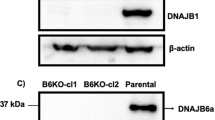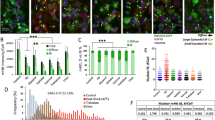Abstract
Huntington's disease (HD) is an inherited neurodegenerative disorder. Here we demonstrate that expression of arfaptin 2/POR1 (partner of Rac1) in cultured cells induces the formation of pericentriolar and nuclear aggregates, which morphologically resemble mutant huntingtin aggregates characteristic of HD. Endogenous arfaptin 2 localizes to aggregates induced by expression of an abnormal amino-terminal fragment of huntingtin that contains polyglutamine (polyQ) expansions. A dominant inhibitory mutant of arfaptin 2 inhibits aggregation of mutant huntingtin, but not in the presence of proteasome inhibitors. Using cell-free biochemical assays, we show that arfaptin 2 inhibits proteasome activity. Finally, we show that expression of arfaptin 2 is increased at sites of neurodegeneration and the protein localizes to huntingtin aggregates in HD transgenic mouse brains. Our data suggest that arfaptin 2 is involved in regulating huntingtin protein aggregation, possibly by impairing proteasome function.
This is a preview of subscription content, access via your institution
Access options
Subscribe to this journal
Receive 12 print issues and online access
$209.00 per year
only $17.42 per issue
Buy this article
- Purchase on Springer Link
- Instant access to full article PDF
Prices may be subject to local taxes which are calculated during checkout





Similar content being viewed by others
References
The Huntington's Disease Collaborative Research Group. Cell 72, 971–983 (1993).
Mangiarini, L. et al. Cell 87, 493–506 (1996).
Wanker, E. E. J. Biol. Chem. 381, 937–942 (2000).
Sathasivam, K. et al. Hum. Mol. Genet. 8, 813–822 (1999).
Kanoh, H., Williger, B. T. & Exton, J. H. J. Biol. Chem. 272, 5421–5429 (1997).
D'Souza-Schorey, C., Boshans, R. L., McDonough, M., Stahl, P. D. & Van Aelst, L. EMBO J. 16, 5445–5454 (1997).
Van Aelst, L., Joneson, T. & Bar-Sagi, D. EMBO J. 15, 3778–3786 (1996).
Shin, O. H. & Exton, J. H. Biochem. Biophys. Res. Commun. 285, 1267–1273 (2001).
Sherman, M. Y. & Goldberg, A. L. Neuron 29, 15–32 (2001).
Waelter, S. et al. Mol. Biol. Cell 12, 1393–1407 (2001).
Suhr, S. T. et al. J. Cell Biol. 153, 283–294 (2001).
Sittler, A. et al. Hum. Mol. Genet. 10, 1307–1315 (2001).
Sittler, A. et al. Mol. Cell 2, 427–436 (1998).
Krobitsch, S. & Lindquist, S. Proc. Natl Acad. Sci. USA 97, 1589–1594 (2000).
Muchowski, P. J. et al. Proc. Natl Acad. Sci. USA 97, 7841–7846 (2000).
Carmichael, J. et al. Proc. Natl Acad. Sci. USA 97, 9701–9705 (2000).
Meriin, A. B. et al. J. Cell Biol. 153, 851–864 (2001).
Chun, W., Lesort, M., Tucholski, J., Ross, C. A. & Johnson, G. V. J. Cell Biol. 153, 25–34 (2001).
Karpuj, M. V. et al. Proc. Natl Acad. Sci. USA 96, 7388–7393 (1999).
Kahlem, P., Green, H. & Djian, P. Mol. Cell 1, 595–601 (1998).
Wigley, W. C. et al. J. Cell Biol. 145, 481–490 (1999).
Bence, N. F., Sampat, R. M. & Kopito, R. R. Science 292, 1552–1555 (2001).
Tarricone, C. et al. Nature 411, 215–219 (2001).
Mineo, C., Gill, G. N. & Anderson, R. G. J. Biol. Chem. 274, 30636–30643 (1999).
Johnston, J. A., Ward, C. L. & Kopito, R. R. J. Cell Biol. 143, 1883–1898 (1998).
Kazantsev, A., Preisinger, E., Dranovsky, A., Goldgaber, D. & Housman, D. Proc. Natl Acad. Sci. USA 96, 11404–11409 (1999).
Dorsman, J. C. et al. Philos. Trans. R. Soc. Lond. B Biol. Sci. 354, 1061–1067 (1999).
Davies, S. W. et al. Methods Enzymol. 309, 687–701 (1999).
Boshans, R. L., Szanto, S., van Aelst, L. & D'Souza-Schorey, C. Mol. Cell Biol. 20, 3685–3694 (2000).
D'Souza-Schorey, C. et al. J. Cell Biol. 140, 603–616 (1998).
Acknowledgements
We thank E. Signer, and J. Schweitzer for discussions and critical reading of the manuscript. We thank J. Exton for arfaptin 2 cDNA, J. Dorsman for huntingtin antibodies, E. Van Donselaar and Erik Bos for excellent technical assistance with EM procedures, A. Mahal for genotyping the mice, O. Spasic-Boscovic for assistance with immunocytochemistry and B. Apostal for assistance with generating the cell line expressing GFP–HttexpolyQ. We acknowledge the EM division of Utrecht University for excellent technical assistance with photography and handling of EM micrographs. This work was supported in part by grants from the Hereditary Diseases Foundation, Cure HD Initiative, to C.D.-S and L.T., and by grants from the Human Science Frontiers Program and the Wellcome Trust to G.B.
Author information
Authors and Affiliations
Corresponding author
Supplementary information
Figure S1
Cytoplasmic distribution of arfaptin 2. (PDF 1310 kb)
Rights and permissions
About this article
Cite this article
Peters, P., Ning, K., Palacios, F. et al. Arfaptin 2 regulates the aggregation of mutant huntingtin protein. Nat Cell Biol 4, 240–245 (2002). https://doi.org/10.1038/ncb761
Received:
Revised:
Accepted:
Published:
Issue Date:
DOI: https://doi.org/10.1038/ncb761
This article is cited by
-
ENC1 Modulates the Aggregation and Neurotoxicity of Mutant Huntingtin Through p62 Under ER Stress
Molecular Neurobiology (2016)
-
ARF proteins: roles in membrane traffic and beyond
Nature Reviews Molecular Cell Biology (2006)
-
Development of an Ischemic Tolerance Model in a PC12 Cell Line
Journal of Cerebral Blood Flow & Metabolism (2005)
-
The role of the ubiquitin/proteasome system in cellular responses to radiation
Oncogene (2003)



